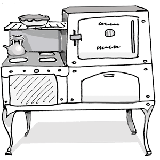Cambridge's Culinary Culture
Cambridge holds a rich and distinctive culinary history. It gave America ice, the Porterhouse steak, Peking ravioli, its first star chef in Julia Child, and a hankering for Indian food.
This is a survey of 20th century markets, delis, cafeterias, and local institutions, divided into three eras. Some thirty establishments are highlighted for their popularity, longevity, and/or reflection of the times. Longtime residents will notice not every beloved spot is included, as there are simply too many to list, or too little information existing. The 2area's many confectioners, such as NECCO and Squirrel Nut, have been omitted as we are planning to feature these spots in a separate site. Similarly, the abundance of ice cream parlors that once populated Harvard Square, like Brigham's and Herrell's, inspires its own survey. And spas, Cantabridgian for old-time neighborhood convenience stores, have not been included, though a few like Montrose Spa continue to operate.
This sampling essentially gives a local snapshot of food culture progressing from fresh and local, meeting the melting pot, mass production, global capitalism, women's equality, a growing health consciousness, New American cuisine, and then slowly heading back to the farm.


